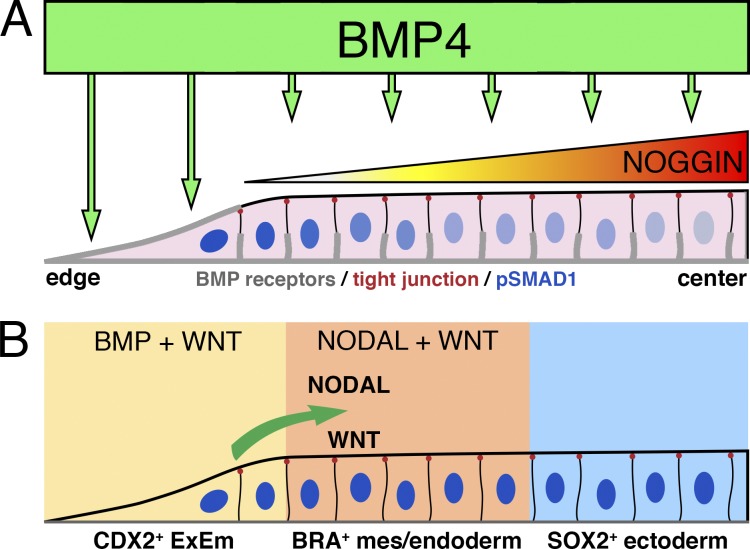File:Gastrulation molecular factors01.jpg
Gastrulation_molecular_factors01.jpg (750 × 549 pixels, file size: 105 KB, MIME type: image/jpeg)
Gastrulation Molecular Factors (micropattern platform)
Formation of primary germ layer–like cells in a micropattern platform orchestrated by BMP signaling.
(A) BMP signaling is most prominent in the edge of micropattern colonies (indicated by nuclear pSMAD1, blue) as basolaterally localized BMP receptors are exposed to exogenous BMP4 ligand (“edge effect”). BMP4 signaling induces the expression of its antagonist NOGGIN, resulting in a NOGGIN gradient that is highest at the colony center. BMP receptors (gray), tight junction (red dots), and nuclear pSMAD1 (blue; Warmflash et al., 2014; Etoc et al., 2016).
(B) Adjacent to the colony edge, BMP-dependent NODAL and WNT expression establishes a mesoderm/endoderm cell population; center cells are maintained as SOX2+ neuroectoderm-like state.
(Text modified from original figure legend)
- Links: gastrulation | BMP | WNT | NOGGIN | NODAL
Reference
Taniguchi K, Heemskerk I & Gumucio DL. (2019). Opening the black box: Stem cell-based modeling of human post-implantation development. J. Cell Biol. , 218, 410-421. PMID: 30552099 DOI.
Copyright
© 2019 Taniguchi et al. This article is distributed under the terms of an Attribution–Noncommercial–Share Alike–No Mirror Sites license for the first six months after the publication date (see http://www.rupress.org/terms/). After six months it is available under a Creative Commons License (Attribution–Noncommercial–Share Alike 4.0 International license, as described at https://creativecommons.org/licenses/by-nc-sa/4.0/).
Figure 3. JCB_201810084_Fig3.jpg
Opening the Black Box - Stem Cell-Based Modeling of Human Post-Implantation Development "Proper development of the human embryo following its implantation into the uterine wall is critical for the successful continuation of pregnancy. However, the complex cellular and molecular changes that occur during this post-implantation period of human development are not amenable to study in vivo. Recently, several new embryo-like human pluripotent stem cell (hPSC)-based platforms have emerged, which are beginning to illuminate the current black box state of early human post-implantation biology. In this review, we will discuss how these experimental models are carving a way for understanding novel molecular and cellular mechanisms during early human development." gastrulation
Cite this page: Hill, M.A. (2024, April 27) Embryology Gastrulation molecular factors01.jpg. Retrieved from https://embryology.med.unsw.edu.au/embryology/index.php/File:Gastrulation_molecular_factors01.jpg
- © Dr Mark Hill 2024, UNSW Embryology ISBN: 978 0 7334 2609 4 - UNSW CRICOS Provider Code No. 00098G
File history
Click on a date/time to view the file as it appeared at that time.
| Date/Time | Thumbnail | Dimensions | User | Comment | |
|---|---|---|---|---|---|
| current | 10:38, 29 June 2020 |  | 750 × 549 (105 KB) | Z8600021 (talk | contribs) | ==Gastrulation Molecular Factors== Formation of primary germ layer–like cells in a micropattern platform orchestrated by {{BMP}} signaling. (A) BMP signaling is most prominent in the edge of micropattern colonies (indicated by nuclear pSMAD1, blue) as basolaterally localized {{BMP}} receptors are exposed to exogenous BMP4 ligand (“edge effect”). BMP4 signaling induces the expression of its antagonist NOGGIN, resulting in a NOGGIN gradient that is highest at the colony center. BMP receptors... |
You cannot overwrite this file.
File usage
The following page uses this file:
